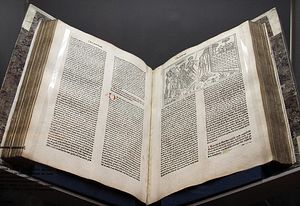Berlin, April 5, 2013

|
The Abbey, founded in 1163, is situated a short distance from the main roads, which is why it avoided the many miseries Catholic monasteries suffered during Reformation, Napoleon's invasion, and the Second World War. In particular, the Abbey library has been well preserved—it contains 80,000 volumes, manuscripts, charters and other documents, including ancient and valuable editions of Bible.
The exposition opens with the showcase with a Gospel manuscript from the 14th century. It is known in the Abbey as the “Bible with Venetian blinds", because a portion of the Latin script and golden paintings are covered with cloth. Another valuable exhibit is the “Köln Bible" dated from 1473. It is considered to be the first known printed illustrated Bible. All its pages were digitalized so anyone who wishes can turn its pages by means of a sensory monitor.
Organizers of the exhibition are planning to change the composition of exhibits of Holy Scriptures every 3-4 months. Apart from this exposition, about 100 events are planned for the celebration of the Abbey's anniversary—concerts, lectures, and seminars, collectively named, "Keeping one's word".
The founder of the former Cistercian Abbey near Lokkum was a local nobleman, count Wulbrand Von Hallermund, who on March 21, 1163 donated to the Order a piece of land near the castle of Lukka. Remains of the castle's walls have survived to this day in a forest south of Lokkum. The new Abbey was built and settled by the brethren from the Volkenroda Abbey in Thuringia. During the period of its flourishing about 180 monks, priests and pious lay-people lived in the Abbey.
